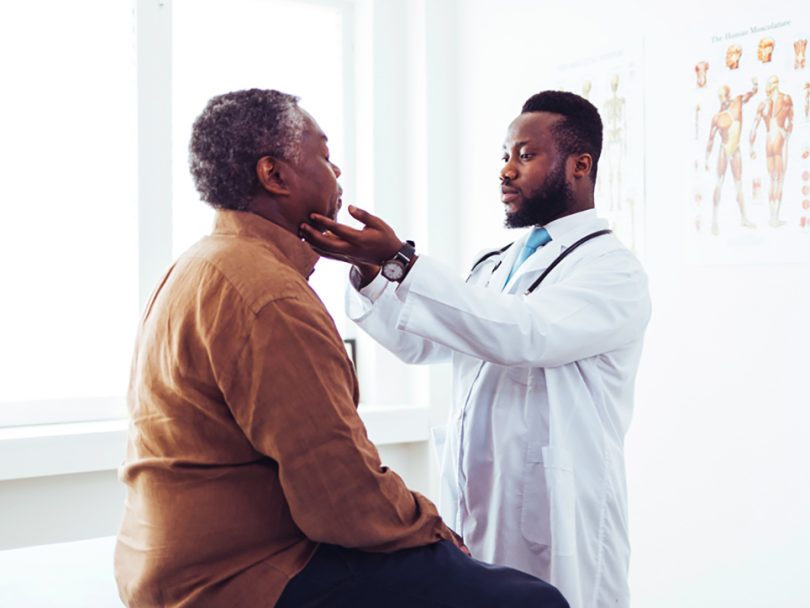Take charge of your head and neck health. Talk to your provider about how you can stay ahead of serious concerns before they start.
Most head and neck cancers—including oral, throat and thyroid cancers—begin in the mouth or throat.
Here are a few steps you can take to keep your head and neck in top shape, so you can live your healthiest life.
Cut tobacco & alcohol
Tobacco use, including smoking and the use of smokeless tobacco such as chewing tobacco or snuff, is a major risk factor for head and neck cancers. The use of alcohol and tobacco together can be especially risky.
“Tobacco use has long been recognized as a risk factor for head and neck squamous cell carcinomas. But combining tobacco with alcohol heightens the risk of those cancers because alcohol increases the absorption of tobacco carcinogens,” said Dr. J. Kenneth Byrd, an otolaryngologist and chief of head and neck surgery at Wellstar MCG Health Medical Center. “It’s best to avoid both for head and neck health.”
According to Dr. Byrd, inhaling anything other than a prescribed medicine, including the use of e-cigarettes and marijuana, could increase the risk as well.
Protect yourself from the sun
Ultraviolet light, such as exposure to the sun or artificial UV rays like tanning beds, is a major cause of cancer on the lips and scalp. Protect your lips by using a lip balm with sunscreen, wear a hat to protect your head from sun exposure and apply sunscreen on your face and neck when you go outside, even in colder weather.
Be mindful of HPV
Human papillomavirus, or HPV, is also one of the main risk factors for head and neck cancers.
“It is well publicized that HPV causes cervical cancer, but it is also responsible for some head and neck cancers,” said Dr. Byrd. “Luckily, the strain of HPV that causes head and neck squamous cell carcinomas is completely preventable with the HPV vaccine. We have done better about encouraging girls and women to get vaccinated, but men account for the majority of head and neck cancer cases, so it is just as important for boys and young men to be vaccinated.”
About 70% of cancers in the oropharynx (which includes the tonsils, soft palate and base of the tongue) are connected to HPV, according to the Centers for Disease Control and Prevention.
HPV is the most common sexually transmitted infection. Talk to your provider about HPV prevention and exposure and seek treatment if you are showing signs of HPV. Although many people with HPV don’t have symptoms, some develop warts in the genital area.
Gardasil-9, the vaccination against HPV, protects patients against the types of HPV that cause most HPV cancers. Patients from age 11 to 46 should consider vaccination after speaking with their provider.
Know the risk factors
Some jobs can also be risk factors. The construction, textile, ceramic, logging and food processing industries can cause exposure to substances like wood dust, formaldehyde, asbestos, nickel and other chemicals. These increase the risk of cancer in the nasopharynx, or the top part of the throat.
And if you have been infected with the Epstein-Barr virus, which causes mononucleosis and some other illnesses, you could be at higher risk. Previous radiation treatments to the head and neck can also increase your risk.
Watch for symptoms
Symptoms of head and neck cancers will vary based on which part of the head and neck they appear. Signs include:
- Hoarseness that persists or worsens over several weeks
- Difficulty swallowing
- Sore throat that does not go away
- A lump that does not go away
- Painless lump in the neck
- A white or red patch on the gums, tongue or lining of the mouth
- Swelling of the jaw
- Bleeding or pain in the mouth
- Blocked sinuses that do not clear up with antibiotic treatment
- Frequent headaches of unknown origin
- Tooth pain or denture problems
- Ear pain
- Swelling near the jawbone or under the chin
- Numbness or paralysis of the face muscles
- Difficulty hearing or pain or ringing in the ears
- Trouble breathing or sleeping
“Recognize any disturbance that lasts longer than two weeks and schedule an appointment to have a healthcare provider evaluate it. It may or may not be cancer, but we will only know for certain if you come in to be seen,” said Dr. Byrd.
While it’s important that everyone look for symptoms of head and neck cancers, these conditions are more likely to affect men. Men are three times more likely to be diagnosed with oral and throat cancer compared to women, according to the American Cancer Society.
If you are showing any symptoms of head and neck cancers, contact your healthcare provider. Annual dental and oral examination by your dentist is the best way to screen for head and neck cancers.
Learn more about how Wellstar MCG Health Medical Center cares for head and neck cancers.


